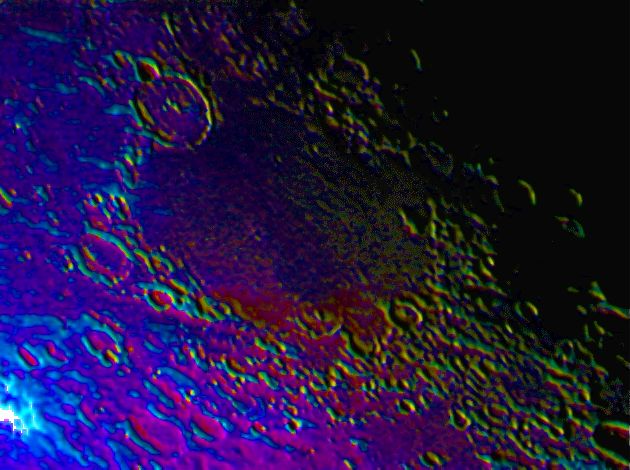

Move your mouse over the picture to see the names of the various craters.
Mare Humorum is the most clearly demarcated of the maria in the western hemisphere,
and is one of the most-clearly defined impact basins on the whole of the visible side of the Moon.
The features of an impact basin don't, unfortunately, show too well in my picture, but the
overall circular nature of the basin is obvious (or would be if perspective hadn't foreshortened
the east-west direction). Something like 3,900 million years ago a massive body impacted
here and created an enormous crater. Later the basin was flooded with lava at least four
times. Before this, however, peripheral craters, such as Gassendi and Doppelmayer, were
formed by impacts on the sloping sides of the basin. When the lavas flooded in they
partially inundated these craters. High-resolution pictures from orbit show that the rim of Gassendi is intact, so its lavas cannot have come directly from Mare Humorum and must have welled up through vents in its floor.
The ring mountains are not as obvious as, for example, the Apennines are for
Mare Imbrium, but an inner ring starting on the western
edge of Gassendi and running round just inside Mersenius, through Vitello and up to Hippalus,
is fairly evident even on this picture. The practised eye (I'm told) can make out an
outer one which would be outside this picture in any case. Within the mare itself there
are indications of inner rings as curved scarps or wrinkle ridges. One of these is
Leibig Scarp, named after the crater just to its west, and the feature probably connects with
a similar scarp seen protruding from the western side of Gassendi. A collection of
wrinkle ridges can be seen at and outside of Puiseux D. Between Hippalus and Campanus you
can see three rilles (the Hippalus Rilles) that are clearly arcuate to the basin. These
probably formed as cracks in the rocks when the centre of the basin sank under the
weight of the lavas that flooded into the basin. If these features don't show clearly
on your monitor, then click on the picture to see a copy of this page with the pictures
brightened up somewhat.
Having taken the picture above, I read about Mare Humorum and learned that it had been
flooded at least four times by different lavas and I regretted not taking a colour picture
with a view to seeing if enhancement of the colours could distinguish these four layers.
So two months later I took a colour picture of the same area. Unfortunately the
conditions were far from ideal with high cloud coming and going. I used my ETX125
telescope for this image; it has a somewhat shorter focal length than my LX200 and
is a lot easier and quicker to set up. The image is shown below.
There is some correspondence between the coloured areas in this picture and the regions of
different lavas (shown on page 154 of Dr. Wood's book The Modern Moon), but it is not close. The dark red to the north of Dopplemayer and south to Lee corresponds quite well to Wood's SHB (South Humorum Basalts), but the central blue area
is much too narrow to correspond to his CHB. Although the green area to the west
of Cape Kelvin corresponds roughly to the EHB region, I am not convinced that is what the picture shows.
I understand that these colours relate to the composition of the ground much more closely when the Sun is high in the lunar sky. This was not the case here. If I calculate correctly, the altitude of the Sun in the region of greenish mottling to the west of Cape Kelvin was only about 12°. I am wondering if what I am seeing there is actually the topography rather than the composition of the ground. In particular, notice that the highlights where the Sun is catching the edges of Gassendi J and O are the same greenish colour as the mottling. This may indicate that I have not got the colour balance quite right, but, be that as it may, there is something showing up in that area. There is a similar mottling, in red this time, on the western side of the mare.

|
Mare Humorum in exaggerated colour. The colour sliders on the camera were adjusted to give, as near as I could manage it, the same reading on the brightness meter in K3CCDTools for each colour. I made two copies of the resulting picture; I reduced the colour saturation to zero for one of these and then applied a slight unsharp-mask. I increased the saturation of the colours to 100% for the other copy and applied a slight gaussian blur. I then recombined these pictures in Registax, and finally increased the saturation and the brightness somewhat in PhotoImpact. (If you would like to see this picture before the colours were enhanced then click here and use the back button to return here.) The markers indicate north and east but are not to scale. The picture was taken with a ToUcam attached to my ETX125 on 27th October 2005 at 0513 UT, when the Moon was 24.1days old. Date and Time: 27th October 2005 0513UT Camera: ToUcam 740K with IR-cut and Neodymium filters Telescope: ETX125 at prime focus Capture: K3CCDTools. Low gamma, high saturation, 1/33", 13% gain, 1042 frames Processing: Registax. 244 frames stacked. Wavelets 1,2 = 10, histogram 0-200 |
Home Back to SW Quadrant